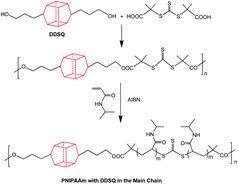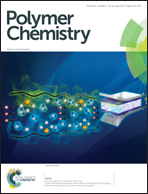Synthesis and characterization of bead-like poly(N-isopropylacrylamide) copolymers with double decker silsesquioxane in the main chains
Abstract
Bead-like PNIPAAm copolymers with double-decker silsesquioxane (DDSQ) in the main chains were synthesized via a reversible addition–fragmentation chain transfer (RAFT) polymerization approach. The macromolecular chain transfer agent used for the RAFT polymerization was synthesized via the polycondensation of 3,13-dihydroxyproplyl DDSQ with S,S′-bis(α,α′-dimethyl-α′′-propargyl acetate)trithiocarbonate. The organic–inorganic copolymers with variable contents of DDSQ were characterized by means of 1H nuclear magnetic resonance spectroscopy and gel permeation chromatography. Transmission electron microscopy showed that the bead-like PNIPAAm copolymers were microphase-separated in bulk. It was found that the glass transition temperatures (Tg's) of PNIPAAm microdomains of the organic–inorganic copolymers were lower than plain PNIPAAm and decreased with increasing the content of DDSQ. The bead-like PNIPAAm copolymers displayed the self-assembly behavior in aqueous solutions. Depending on the content of DDSQ, the bead-like organic–inorganic copolymers can self-assemble into spherical or vesicular nanoobjects in aqueous solutions. Both micro-differential scanning calorimetry (Micro-DSC) and cloud point analysis with UV-vis spectroscopy showed that the lower critical solution temperature (LCST) behavior of PNIPAAm subchains in the bead-like copolymers was significantly affected by the POSS cages in the main chains.


 Please wait while we load your content...
Please wait while we load your content...